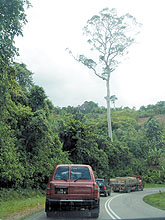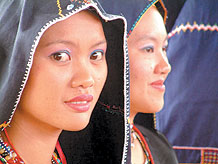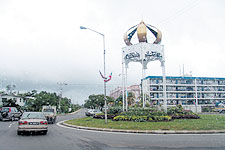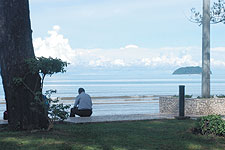With around 32 indigenous groups,
Sabah, better known as the "
Land Below The Wind", is certainly rich in its unique and colourful cultural heritage.
The Kadazandusun is the largest ethnic group in Sabah and among its prominent community leaders are Sabah Deputy Chief Minister Joseph Kitingan.
Predominantly wet rice and hill rice cultivators, their language belongs to the Dusunic family and shares a common animistic belief system with various customs and practices.
Their ancient beliefs on the verity that everything has life - the rocks, trees, and rivers are all living things, which have souls and spirits that must be appeased from time to time through specific rituals.
But in these modern times, some of the rituals are less performed except during certain festivities such as the Pesta Kaamatan or Harvest Festival, regarded as a unique celebration of the Kadazandusun.
As a celebration to honour the Rice Spirit - Bambaazon or Bambarayon and giving thanks for yet another bountiful year, the festival begins on the first of May at many district levels.
The rites and customs of the Pesta Kaamatan is a tribal practice of Kadazandusun and also Murut peoples.
The Bobohizan or Bobolian who are the High Priests or Priestesses will conduct the ritual but in different districts, the priests or priestesses may be addressed to differently, for instance in Tambunan district they are known as Bobolian, in Tuaran as Tantagas and in Penampang as Bobohizan.
It is believed that rice in whatever form embodies Bambaazon that must be protected from harm and as such the homecoming of Babaazon is an integral part of the Harvest Festival, which always ends with food offerings and merry-making for the village folks.
In the old days, this ceremony was often performed in freshly harvested fields during the first full moon after the harvest to invoke the rice spirit.
The highlight of Pesta Kaamatan is the selection of the pageant queen or "Unduk Ngadau" which can be literally translated as "Zenith of the Sun".
Whereas the Murut, which literally means "hill people", are mostly shifting cultivators and hunters with some riverine fishing.
Being one of the largest indigenous groups in Sabah, Murut comprise of subgroups such as Baukan, Gana', Kalabakan, Okolod, Paluan, Sulangai, Serudung, Tagal, Timugon and the Beaufort and Keningau Murut.
They inhibit the interior and southeastern parts of Sabah and the territory straddling the Kalimantan and Sarawak borders besides speaking 15 languages and 21 dialects.
The language commonly used and understood by the large majority is Tanggal apart from being related to the Kadazandusun languages.
Once feared as fearless headhunters and longhouse dwellers, the Murut these days have abandoned much of their age-old traditions especially headhunting.
They are also very skilled in hunting with blowpipe, which can be traced back to the by-gone era when collecting heads of enemies served a very precise function in Murut society.
Back then a man can only get married after he has presented at least one head that he has hunted to the family of the desired girl. Heads also play a very important role in spiritual beliefs.
The essence of Murut tradition of feasts is distinctive and no merrymaking will end at least until sunrise and can last up to seven days later.
This is especially the case with weddings or funerals but fortunately through modernisation, no more heads must be furnished for weddings.
Instead jars along with cloth, beads, gold and ivory bracelets have taken its place, with all these dowry items being proudly displayed at the ceremony.
Jars or "sampa" holds a prominent status in their customs, which are treated with due respect, they are a place of spirits.
Like the culture of certain Borneo tribes, beads play an integral role in Murut life for which wedding beads must be presented in the form of belts, necklaces, headgear and decoration.
The wedding ceremony must be held in the bride's longhouse, tapai or rice wine must be served and all the meat has to be pickled.
The Murut keep the bodies of their deceased in a jar and place them in colourful and elaborately decorated grave-huts along with the deceased's belongings.
The body will be placed in the foetal position inside the jar and a gong will be placed over the mouth of the jar to close it.
However this custom of burial is becoming rare with the availability of wooden coffins.

























